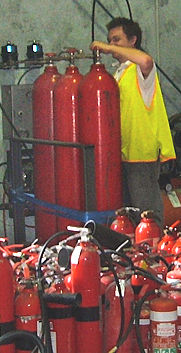Fire Extinguisher Pressure Testing
A Guide for Building Services Managers
According to the Australian Standard, fire extinguishers should be pressure
tested (a process called hydrostatic testing) after 5 years to ensure that the
cylinder is safe to use. Testing necessitates the complete discharge of the
extinguisher (ie it has to be emptied). If the extinguisher passes the pressure
test, it needs to be recharged with replacement extinguisher.
If you add in the cost of transport, labour and a possible failure rate,
It is generally cheaper to replace a dry chemical DCP extinguisher, than it
is to test & recharge it.
A new extinguisher looks better, and of course has better usable life.

The main cost of a CO2 fire extinguisher is mostly in its cylinder, so testing
and recharging a CO2 fire extinguisher is usually cost effective: ie the test
& recharge cost is usually less than the cost of replacing them with new
ones.
If an extinguisher fails the hydrostatic pressure test, then you will also
incur a disposal fee. The correct disposal of fire extinguishers should be left
to the experts, there are rules to conform to!
With water, AFFF, and wet chemical fire extinguishers, it may be economic
to test & recharge for the larger ones, but generally not for the smaller
ones.
There is an inconvience factor to consider- you can't just ship them off to
be tested unless you have something to replace them with. Many fire service
companies will do this for you, but you should ask for a quote first, the total
is likely to be higher than replacing them. Don't just ask your fire service
company to quote on replacing, they often overcharge. We specialise in building
lots- so let us quote, you'll be surprised how
cheap a bulk supply can be! You'll also find out why fire service companies
hate supply-only quotes...
If you replace like with like, you do not need any particular expertise. Replacing
the fire extinguishers with new ones can be done by your building handyman.
We have Testing depots in Sydney, and Newcastle
During testing, the extinguisher valve assembly is cleaned & inspected.
We also check the o-ring and pressure gauge. There is an extra charge if any
of these parts need replacing. Extinguishers are recharged in accordance with
Australian Standards 2337.1 at an SAA approved test station. After recharging,
all units are tested in a water bath for leaks. We specialise in building lots-
so let us quote
For information on fire extinguisher types, and where to locate them, visit our resources page
How do Fire Extinguishers Work?